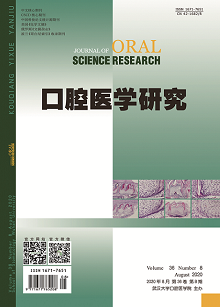|
|
Assessment of Color Changes and Color Rebounds in Enamel, Dentin-enamel junction, and Dentine during Vital Bleaching
SU Weizhu, WANG Yining, MA Xiao
2020, 36(8):
786-792.
DOI: 10.13701/j.cnki.kqyxyj.2020.08.019
Objective: To investigate the changes of color and color rebounds in the enamel, dentine, and DEJ following 14 days vital bleaching treatment and to determine the mechanism of vital tooth bleaching. Methods: 12 extracted premolars were sectioned bucco-lingually in half and randomly bleached with 10% carbamide peroxide (CP) (group A) or 38% hydrogen peroxide (HP) (group B) for 14 days with two bleaching techniques. Photographs were taken prior to bleaching, day 3, 7, and 14 during bleaching, and day 3, 7, 14, 21, 28, and 35 after bleaching in group A; and day 1, 7, and 14 during bleaching, and day 3, 7, 14, 21, 28, and 35 after bleaching in group B. All photographs were digitized, calibrated, and converted to L*, a*, b* values and analyzed using repeated measures analysis of variance. Results: On day 14 , the ΔE of enamel and DEJ were significantly higher than that of dentine in group A and B(P<0.01). The ΔL* of DEJ was significantly higher than that of dentine, while the Δb* was opposite(P<0.05). In group A, 5 weeks after bleaching, the ΔE and ΔL* of enamel and DEJ were significantly higher than that of dentine, while the Δb* was opposite (P<0.01). In group B, 2 to 5weeks after bleaching, Δb* of enamel was significantly lower than that of dentine, and ΔE of enamel and DEJ were significantly higher than that of dentine (P<0.05). With respect to Δa*, only small changes amounting to 0.67 to 2.44 could be observed after bleaching treatment in all specimens. The color relapse rate (CRR) of enamel, dentine, and DEJ were all more than 30% in 5 weeks after bleaching. On day 14 , ΔL* of enamel in group A was significantly higher than group B(P<0.01). ΔL* of dentine in group B was significantly higher than group A, while Δb* was opposite(P<0.05)in 5 weeks after bleaching. Conclusion: The color changes in enamel and DEJ might have a certain contribution to that of tooth color during tooth bleaching, while the color changes in dentine might play a small role in the color changes of the whole tooth.
References |
Related Articles |
Metrics
|

